The tombs, palaces, and imperial citadel have always been ancient and famous tourist attractions in Hue from the past until now. However, that alone is not enough. To ensure your adventure is complete, today’s article from VnCarRentals.com’s provides you with the top 50 famous tourist Attractions in Hue.
Table of Contents
TICKET PRICES FOR VISITING HUE TOURIST ATTRACTIONS
When visiting Hue, tourists will seek information about the ticket prices for tourist attractions in the ancient capital of Hue. The applicable rates until December 31, 2021, are as follows:
- Bach Ma Village: 100,000 VND/1 visitor
- Ca Hue on the Perfume River: 100,000 VND/1 visitor
- Tomb of King Khai Dinh, Tomb of King Minh Mang, Tomb of King Tu Duc:
- Vietnamese visitors: 150,000 VND/adult, 30,000 VND/child
- Foreign visitors: 150,000 VND/adult, 30,000 VND/child
- Imperial City + Museum of Antiquities:
- Vietnamese visitors: 200,000 VND/adult, 40,000 VND/child
- Foreign visitors: 200,000 VND/adult, 40,000 VND/child
- Dan Nam Giao: 50,000 VND/adult, free for children
- Dien Hon Chen: 50,000 VND/adult, free for children
- Alba Thanh Tan Hot Spring Resort: 160,000 – 170,000 VND depending on services
- Truc Lam Bach Ma Zen Monastery: 60,000 VND/1 visitor
- Bach Ma National Park: 60,000 VND/adult, 20,000 VND/child
- YesHue Eco Tourist Area: 150,000 VND/1 visitor
Read more articles about: Entrance Fee – Ticket price to visit Hue 2023 Updated
TRANSPORTATION TO HUE TOURIST ATTRACTIONS
Based on my experience traveling to Hue, the choice of transportation to tourist destinations is crucial. Each mode of transportation offers visitors unique and fascinating experiences.
Motorbike Rental
Many tourists opt to rent motorbikes in Hue to explore tourist attractions, as it is one of the enjoyable means of transportation. Riding a motorbike allows you to have more time to explore various places. Additionally, it provides a comfortable and leisurely experience, allowing you to learn more and gain valuable insights.
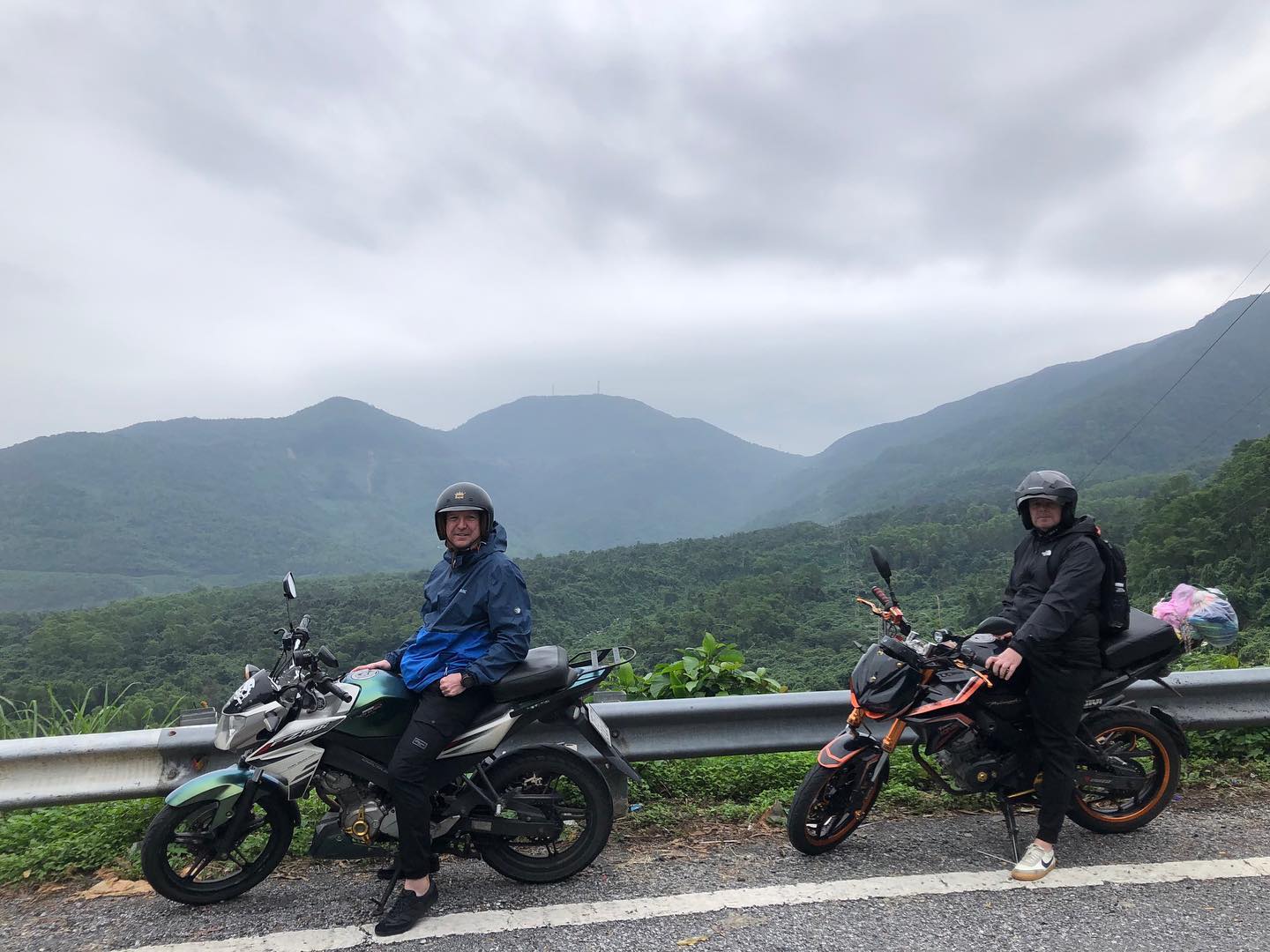
Another option is to choose a motorbike tour service from DanangMotorbikeAdventure.com to discover the tourist attractions in Hue. There are some popular tours such as the Hue To Hoi An Motorbike Tour or the Culinary Discovery Tour in Hue by motorbike, exploring the city of Hue by motorbike tour,…
Book a private car service from VnCarRentals.com
Furthermore, if you are traveling with a group or family and prefer flexibility in terms of time, you can choose to book chauffeured car services in Hue. Opting for this service allows you to have more control over your schedule, eliminating the need to wait for or adhere to a fixed itinerary. You can provide your own itinerary, and the driver will accommodate your plans accordingly. Notably, the drivers in Hue are extremely friendly and enthusiastic.
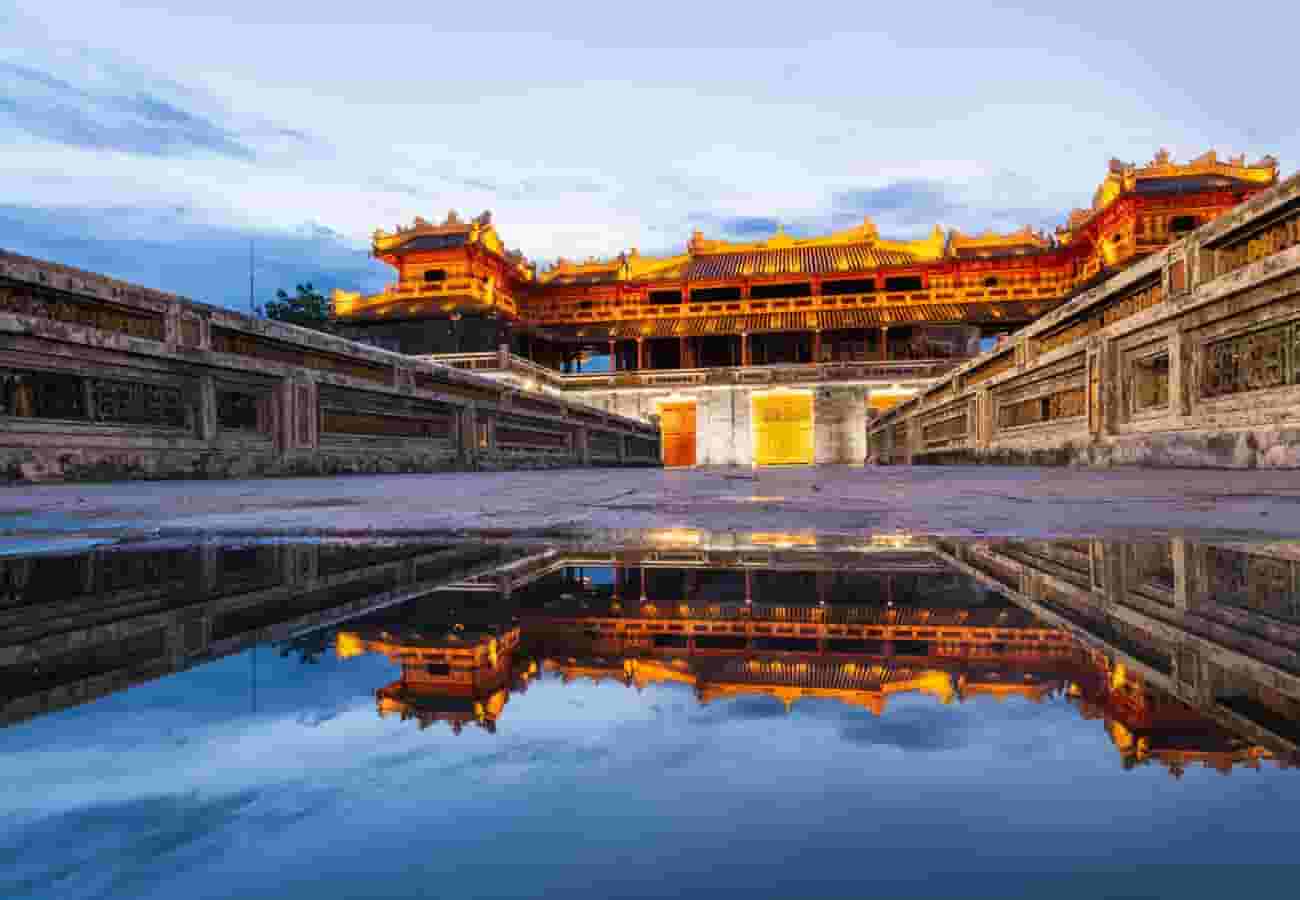
Top 50+ Famous Tourist Attractions in Hue
Tourism in Hue: Palaces and Imperial Citadel
Ngo Mon Gate, Hue
- Address: Part of the Imperial City of Hue
First, we need to know that the Imperial City of Hue is located within the larger area of the Imperial Citadel of Hue. This area includes smaller parts such as the defense section, the worship section, and the section for grand ceremonies.
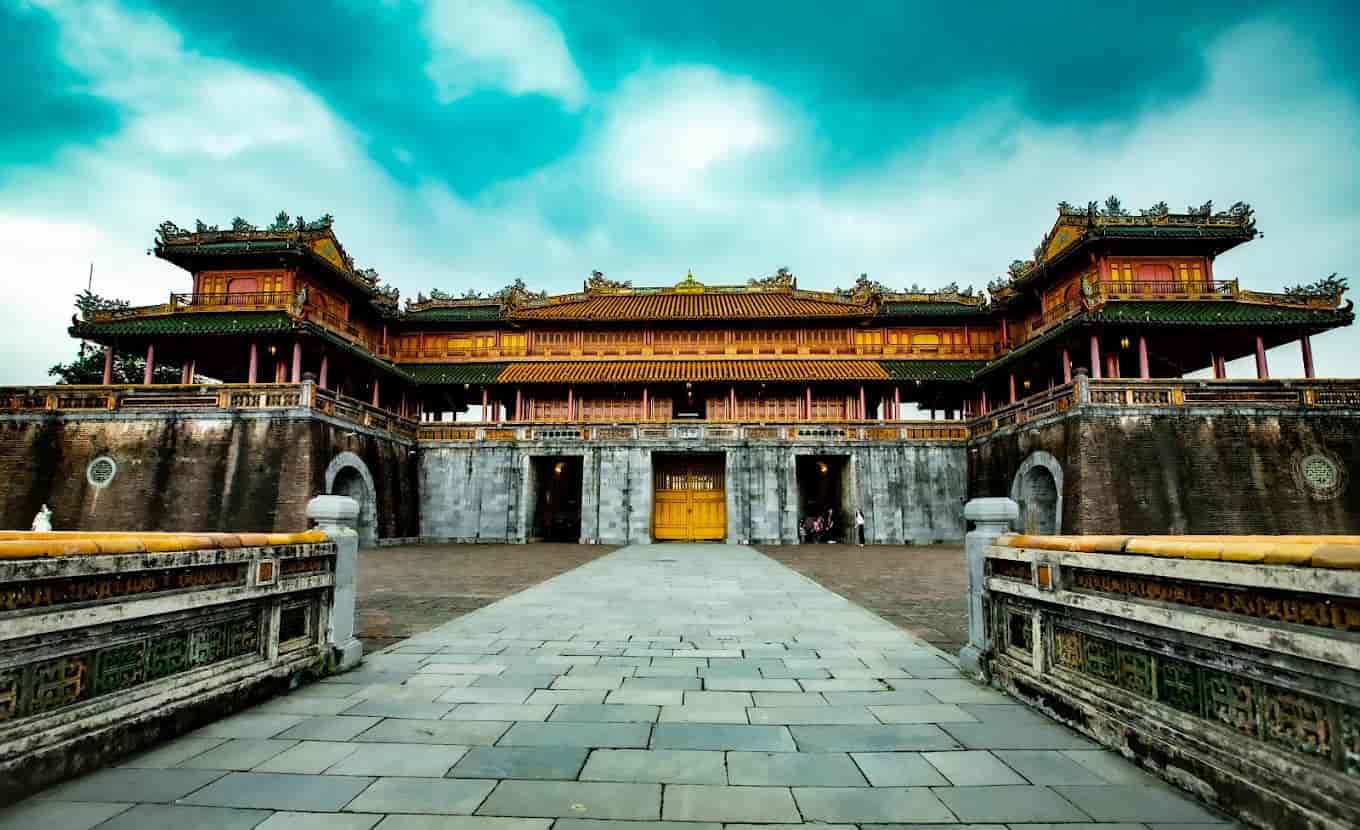
The Imperial City has four gates placed at different positions, with the main and largest gate named Ngo Mon Gate. Ngo Mon faces south, towards the Perfume River, which flows abundantly every day. Whenever the king passed through here, both civil and military officials had to stand on both sides, paying respects with folded hands.
Because of its historical and cultural significance, Ngo Mon Gate is always a must-visit location in tours of Da Nang, Hoi An, and Hue for 3 days and 2 nights.
Dien Tho Palace
- Address: Part of the Imperial City of Hue
Dien Tho Palace is a tourist destination in Hue with the largest-scale palace architecture in the Hue Citadel. This place used to be the residence of many esteemed Queens and Empresses.
After several renovations, the exact size of Dien Tho Palace is now 17,500m2. This area includes the main Dien Tho palace, Tho Ninh palace, Tinh Minh floor, etc. It is also part of the top 16 list recognized as a world cultural heritage.
Thai Hoa Palace
- Address: Part of the Imperial City of Hue
In the Nguyen dynasty era, Thai Hoa Palace symbolized the power of the imperial dynasty. At the same time, significant royal ceremonies took place here.
The palace is built on a 1-meter high platform, with a total area of 1360m2, grand and magnificent. Important events such as the king’s enthronement, longevity celebrations, or receptions for important foreign dignitaries all happened in this area.
Observant visitors will notice a unique feature here – the numbers 5 and 9 are emphasized in the architecture, not only in the buildings but also in the palace’s steps. According to experienced travelers in Hue, these numbers carry Feng Shui and lucky meanings.
Forbidden Purple City
- Address: Part of the Imperial City of Hue
Still within the area of the Hue Citadel, the Forbidden Purple City was the living and working place of the ancient imperial rulers. This place gathers a diverse range of architectural structures, including Can Thanh Palace, Can Chanh Palace, Ta Vu, and Huu Vu. In this area alone, over 50 different constructions have been identified.
In terms of layout, the Forbidden Purple City is rectangular with a perimeter of 1,229.36 meters, entirely built with brick walls. This layout is tight and balanced compared to neighboring areas, clearly reflecting the imperial dominance. This place is nothing short of a small royal universe.
An Dinh Palace
- Address: 97 Phan Dinh Phung Street, Hue City
An Dinh Palace is a tourist destination in Hue facing the Perfume River. The surrounding area only includes thick walls and bricks. When first built, An Dinh Palace contained 10 structures, but due to erosion over time and war damage, only 3 structures remain today.
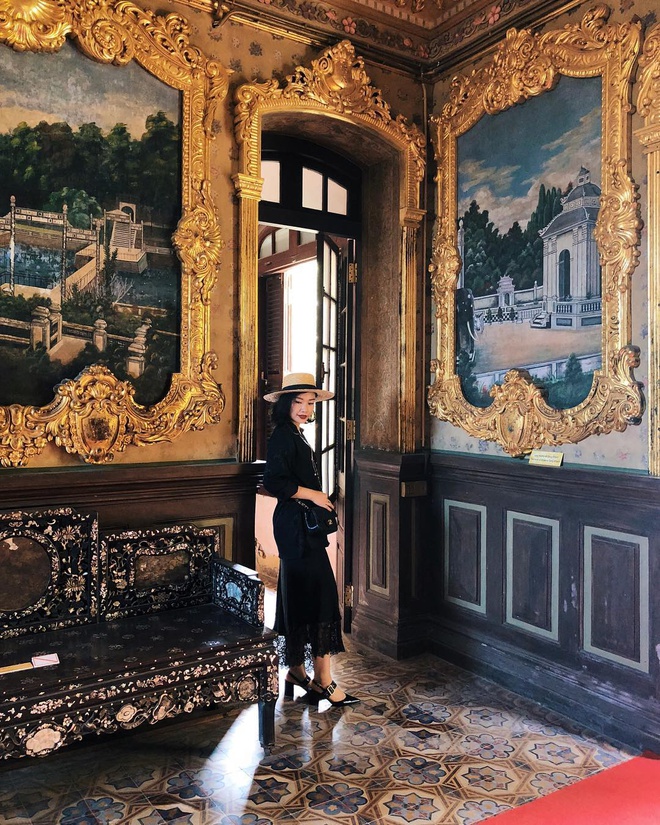
The remaining three structures are: the main gate, Trung Lap shrine, and Khai Tuong floor. Among them, Trung Lap shrine has a hexagonal roof structure, elevated, with a bronze statue of King Khai Dinh inside.
Truong Sanh Palace
- Address: Part of the Hue Citadel heritage
Truong Sanh Palace, also known as Cung Truong Sinh or Cung Truong Ninh, initially functioned as a garden for people to enjoy the scenery. Later, for various reasons, it became an activity area for some Empresses and Queens, specifically Queen Le Thien Anh, Queen Tu Minh, Queen Tien Cung, who were the consorts of Kings Tu Duc, Duc Duc, and Dong Khanh, respectively.
In 1990, when the conservation order for the Hue Citadel heritage was issued, the local residents in this area gradually moved out. The restoration and preservation efforts of this heritage cost nearly 30 billion VND.
Spiritual Tourist Sites in Hue – Spiritual Tourism
Thien Mu Pagoda
- Address: Huong Hoa, Hue City, Huong Hoa, Hue City, Thua Thien Hue.
Thien Mu Pagoda, also known as Mua Linh Pagoda, is located on the left bank of the Perfume River. The pagoda is approximately 5km away from the central area of Hue and is one of the most popular tourist destinations in Hue.

The name “Thien Mu” has various legends associated with it. However, the most widely believed story is about Lord Nguyen Hoang, who, while defending Thuận Hòa province, discovered Hà Khê hill, shaped like a dragon turning its head backward.
Local residents often discuss an old lady dressed in red, who frequently appears alone on the hill, making political prophecies. She predicted that the Southern region would prosper due to righteous individuals. Upon hearing this, Lord Nguyen Hoang joyfully built a pagoda on the hill to worship and named it Thien Mu Pagoda. These legends attract many visitors to the pagoda.
The Mieu (Temple of the Generations)
- Address: Le Huan, Phu Hau, Hue City, Thua Thien Hue.
Temple of the Generations is a wooden structure built in the “double turtle” architectural style. The rectangular area covers over 2 hectares, including the main house, front house, and connected single-roof structures.
Inside this tourist site in Hue, there are other structures such as Tho Cong Tu, Cuu Dinh, Hien Lam Hall, coexisting alongside the Ancestral Temple.
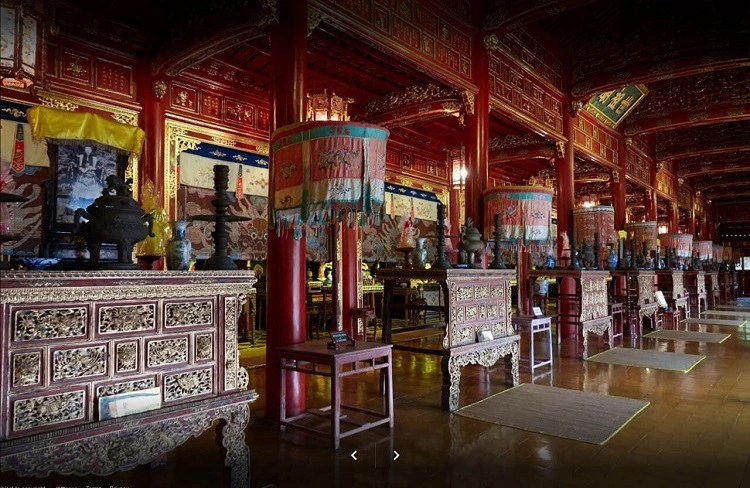
In front of the Temple of the Generations is a wide brick courtyard with 14 stone pedestals and decorative porcelain flower pots. At the end of the courtyard, there are nine large copper vases aligned with nine shrines inside the temple, representing good fortune in feng shui.
Khai Dinh Tomb
- Address: Khai Dinh, Thuy Bang, Huong Thuy, Thua Thien Hue.
Also known as Ung Tomb, Khai Dinh Tomb is located 10km from the center of Hue city. It is an architectural work from the late Nguyen Dynasty. Despite being the smallest in terms of area among the Nguyen Dynasty tombs, it holds significant historical value.
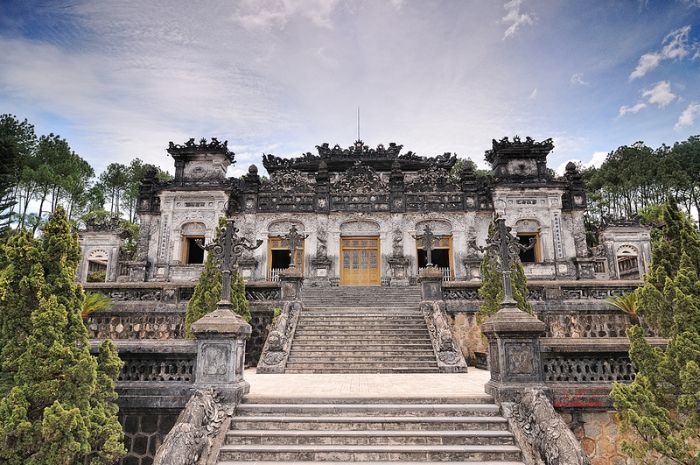
Examining the architecture, there is a clear blend of Eastern and Western cultural influences, reflecting the extravagance of the ruling kings at that time. Materials used for this tourist site in Hue include iron, steel, cement, Ardoise tiles, representing contemporary materials of that era. Inside Khai Dinh Tomb is Thien Dinh Palace, displaying bas-reliefs made of porcelain, pottery, and glass imported from various countries like China and Japan. This location served as the burial site for King Khai Dinh.
Gia Long Tomb
- Address: Huong Tho, Huong Tra, Thua Thien Hue.
Gia Long Tomb is the mausoleum of Emperor Gia Long, also known as Thien Tho Tomb. Construction began in 1814, and it was completed around 1820, taking approximately six years.
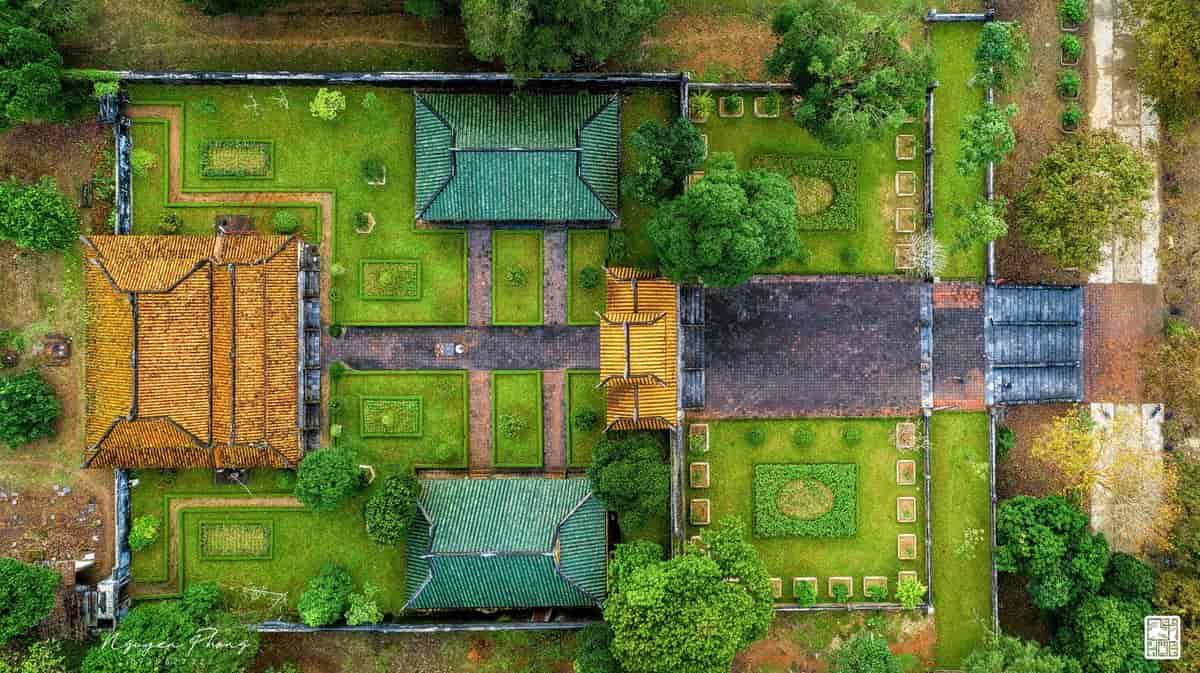
The entire tomb area consists of 42 large and small hills, with Dai Thien Tho being the largest hill. In terms of layout, the tomb is divided into three main areas: the middle part is the tomb of the king and Queen Thua Thien Cao Hoang Hou. The right side is Minh Thanh Palace, dedicated to the emperor and the first queen, and the left side is Bi Dinh Tomb area.
Hon Chen Temple
- Address: Huyen Tran Cong Chua, Huong Tho, Huong Tra, Thua Thien Hue.
Among the tourist sites in Hue with many legends, Hon Chen Temple is perhaps the most renowned. Folk stories suggest that the name Hon Chen, also known as Hoan Chen, implies “returning the jade cup.”
This story is linked to an event when King Minh Mang accidentally dropped a jade cup into the Perfume River, and a turtle swam up to return it. Although the official name of the temple is Ngoc Tran Son Tu, the name Hon Chen is still popular and familiar.
Tu Dam Pagoda
- Address: 1 Su Lieu Quan, Truong An, Hue City, Thua Thien Hue.
Tu Dam Pagoda, founded by Zen Master Minh Hoang – Tu Dung in the 17th century, is one of the ancient and prestigious tourist sites in Hue. Initially, Tu Dam Pagoda was a small monastery built with leaves and earthen walls. Thanks to the trust of the local people, the pagoda underwent several renovations and now has the appearance it has today.
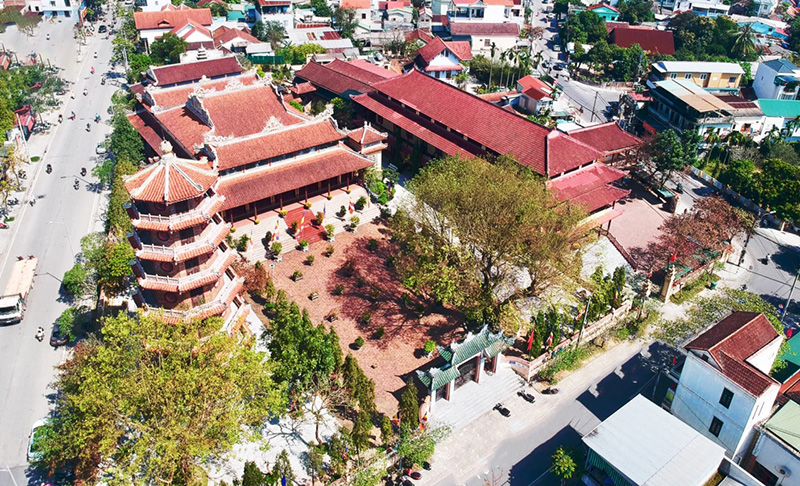
The main area of the pagoda consists of three buildings with tiled roofs, facing southeast. The new construction of the pagoda in 2006 follows the “double turtle” architectural style, a traditional style in Hue. Next to the main hall are two areas for guests and monks.
Kien Trung Palace
- Address: 32 Dang Thai Than, Phu Hau, Hue City, Thua Thien Hue.
On November 6, 1925, Kien Trung Palace became the place where King Khai Dinh passed away, handing over the throne to the next king, Bao Dai. This area represents a complex mix of European styles, incorporating the essence of French architecture, Renaissance architecture, Italian architecture, and, of course, Vietnamese culture. The front of the building is adorned with many pieces of colorful porcelain and pottery, creating a striking first impression for visitors.
Kien Trung Palace was destroyed in 1964 by the Viet Minh army, but it is currently undergoing reconstruction and is expected to be completed by 2020.
Dieu De Pagoda
- Address: Bach Dang, Phu Cat, Hue City, Thua Thien Hue.
Previously, King Thieu Tri used Dieu De Pagoda as his residence, and after ascending to the throne in 1844, he conferred the title of Quoc Tu to this pagoda. The location of the pagoda is along the banks of the Hau Thanh River, commonly known as the Gia Hoi or Dong Ba River. This position is of great significance in the history of Buddhism. Due to its beautiful scenery of gardens, rivers, and poetic surroundings, this place has long been famous in the imperial capital.
Huyen Khong Son Thuong Pagoda
- Address: Cham, Huong Ho, Huong Tra, Thua Thien Hue.
One of the must-visit tourist sites in Hue is Huyen Khong Son Thuong Pagoda. Situated amidst the mountains and adjacent to the surrounding pine forest, the area is always lush and cool.
The main hall of the pagoda is a variation of the traditional communal house with materials that blend seamlessly with nature. Unlike the familiar design of other temples, this place does not have a grand Tam Quan gate; instead, it features a small gate just wide enough for entrance to the garden, where various ornamental trees are displayed, such as violet mimosa, orchids, bonsai, and pine trees.
Minh Mang Tomb
- Address: QL49, Huong Tho, Huong Tra, Thua Thien Hue.
Regarding layout and architecture, Minh Mang Tomb embodies a poetic blend of nature and human creativity. The tomb is surrounded by the Luu Khiem Lake on three sides, giving it a unique charm. At the entrance, there is a gate with the inscription “Tomb of Thanh Thai Emperor.” Going further, there is the Honor Courtyard, the Salutation Court, the Stele Pavilion, and the main temple, showcasing the emperor’s accomplishments.
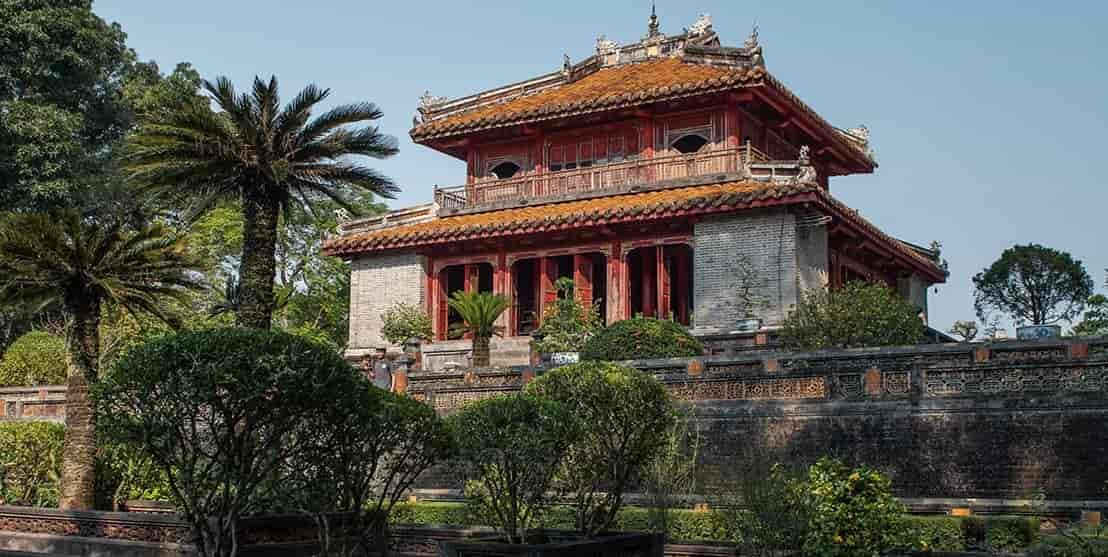
The architectural style of Minh Mang Tomb follows strict rules, with a focus on harmonizing with nature. Throughout the entire area, the combination of hills, lakes, and buildings creates a picturesque landscape that reflects the Nguyen Dynasty’s spiritual beliefs.
These spiritual tourist sites in Hue represent the rich cultural and historical heritage of the region, offering visitors a glimpse into the traditions, architecture, and legends that have shaped the area over the centuries.
Thien Lam Pagoda
- Address: Quang Te Hill, Thuy Xuan Ward, Hue City
From the entrance, visitors can already appreciate the beauty on both sides of the road. The entrance carries the traditional yellow color of Buddhism, with a statue of the Buddha in a meditative pose on the left and in front, the Yaksha guarding against disturbances.
Upon entering, visitors will witness a bronze Buddha statue in a solemn standing posture. Looking to the left, there is a two-story tower. The year 1966 marks the completion of the pagoda, representing the Southern Zen tradition.
Voi Re Palace
- Address: Ngo Ha, Thuy Bieu, Hue City, Thua Thien Hue
Located about 5km southwest of the city center of Hue is Voi Re Palace. It is a relic of the Nguyen dynasty and a tourist destination within the imperial citadel.
Legend has it that when ascending the throne, King Gia Long ordered the construction of a palace next to the elephant tomb, officially named Long Chau Mieu but commonly known as Voi Re Palace.
This architectural complex covers an area of about 2,000m2, employing Feng Shui principles with Thanh Loi as a screen, an outer wall built with bricks, and a lotus pond.
In the early days of Voi Re Palace, the royal court allocated considerable gold and silver for ceremonies twice a year. The image of elephants serving courageously in battles was highly revered, even equating them with divine beings. The palace served to pray for peace for humans and the elephants’ escape from the battlefield.
Tu Hieu Pagoda
- Address: Thuy Xuan, Hue City, Thua Thien Hue
Venerable Nhat Dinh was the one who took over the management of Bao Quoc Pagoda, bringing his elderly mother here for the purpose of meditation, nurturing, and showing filial piety.
According to folklore, the mother was seriously ill, and despite constant attempts to use medicinal herbs, there was no improvement. Someone suggested buying fish meat to nourish her, but the Zen master vehemently refused, dismissing the suggestion.
Touched by this act of filial piety, the news reached King Tu Duc, who, impressed, granted the temple the name “Sac Tu Tu Hieu Tu.” “Tu” means the great virtue of Buddha, and “Hieu” is the filial piety of Buddha. The king also provided funds to rebuild the temple, making it a famous spiritual destination.
Hung To Temple
- Address: Le Huan, Phu Hau, Hue City, Thua Thien Hue
Hung To Temple is the temple honoring the double nature of King Gia Long, namely Crown Prince Nguyen Phuc Luan and Mrs. Nguyen Thi Hoan. If there was no internal power struggle within the Nguyen family, Nguyen Phuc Luan would have ascended the throne sooner.
However, the tragic end of his life came when Truong Phuc Loan seized power, leading to his imprisonment and early death at the age of 32. Nevertheless, six of his children later, one of them ascended the throne as Emperor Gia Long.
Upon becoming king, Gia Long immediately built a tomb for his father to worship. Historical records state that the construction took about 4 months. In 1821, King Minh Mang ordered the relocation of Hoang Khao Temple 50m back to build The Mieu. After completion, he officially renamed it Hung To Temple – the name it holds today.
Tu Duc Tomb
- Address: 17/69 Le Ngo Cat, Thuy Xuan, Hue City, Thua Thien Hue
Even during his lifetime, King Tu Duc had already planned to build a tomb for himself. He chose a resting place worthy of his achievements, a narrow valley in the total of Cu Chanh.
The Tu Duc Tomb consists of a total of 50 structures, with paved walkways. After the electric crematorium area, there is the tomb area. Two rows of statues of civil and military mandarins stand on either side of the king’s resting place, with an inscription on the stone slab nearby reading “Khiem Cung Ky,” a text composed by the king himself.
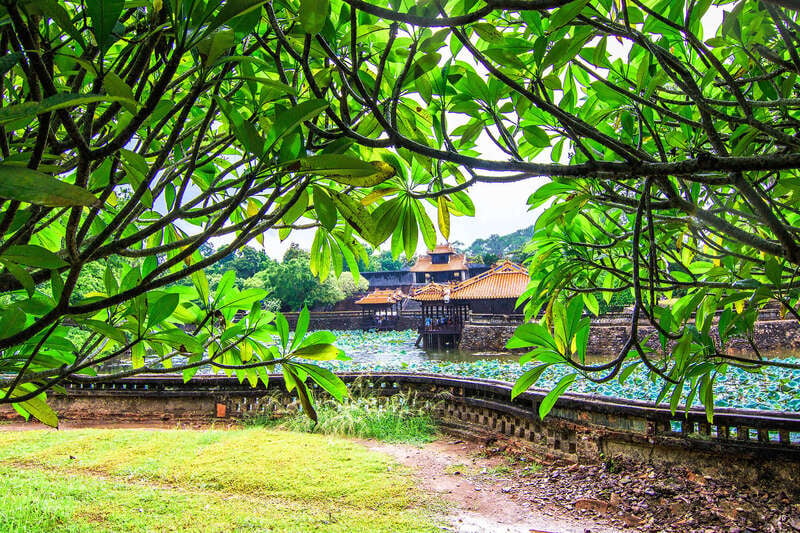
During his lifetime, King Tu Duc had over 103 wives, but he had no heirs. Before his death, he carved a stele with a lengthy inscription of 4935 characters to recount his life from his reign to personal illnesses, historical offenses, and more. Behind this stele are two pillars with the lake of Tieu Khiem, symbolizing the purification of the king’s soul. Today, this place is a popular tourist destination in Hue.
Tourist Museums in Hue
Le Ba Dang Art Museum
- Address: 15 Le Loi, Vinh Ninh, Hue
The museum is a highly recommended destination for tourists. Despite its relatively small size compared to other similar spaces, it boasts impressive and elegant exhibition designs. When visiting, you will marvel at the French-style architecture and famous paintings by talented artists.
The museum charges a small fee at the entrance and has a lunch break from 11:30 am to 1:30 pm. To avoid waiting, it is advisable to arrive before or after this time. When it comes to tourist destinations in Hue, the art at Le Ba Dang Art Museum is an irresistible attraction.
Ho Chi Minh Museum
- Address: 7 Le Loi, Vinh Ninh, Hue
Thua Thien Hue is where the childhood spirit of the national leader was nurtured. During the years spent here, he left numerous legacies, with more than 20 memorabilia items commemorating his presence.
These values not only serve tourism and exploration but also aim to enrich the people, making the nation strong and ensuring national security.
Hue Imperial City Antiquities Museum
- Address: 03 Le Truc, Phu Hau, Hue
This tourist destination in Hue is located within the Imperial City and is the earliest established museum. It houses an estimated 700 artifacts, many of which are not only ancient but also high-quality and invaluable.
The exhibition space is divided into various themes for easier exploration, such as the royal gaming area, royal costumes area, a collection of ceramics, and artifacts from the imperial court.
Nguyen Dynasty Ceramics Museum
Visiting the Nguyen Dynasty Ceramics Museum allows tourists to freely explore precious and intricate artifacts, ranging from daily household items to treasures of kings, lords, and nobles. Among the treasures are valuable items like betel trays, lime pots, betel nut cutters, tea sets, and tobacco pipes.
Moreover, the house itself that contains these items is a treasure built since 1920. The house follows the traditional architectural style of Hue’s ancient houses. It is known that the owner of the house is Mr. Tran Dinh Son, a descendant of the Hinh family, who served as a high-ranking official under the Nguyen Dynasty. The house and its interior have been preserved almost intact until today. Tourists visiting the cultural and ethnically rich destination of Hue should not miss this place.
Hue War Museum
- Address: 23/8, Hue
Hue War Museum showcases the remnants of the blood-soaked wars, providing a tangible experience of the horrors that might be hard for future generations to imagine. Although the museum is not large, its value is immeasurable. The old tanks and planes serve as material evidence of the difficult physical efforts. Its antiquity is the most authentic color for viewers to appreciate compared to the current times they are living in.
Hue Cultural Museum
- Address: 23 – 25 Le Loi, Hue
Still bearing the historical imprint, this tourist destination in Hue evokes various shades of memories. As time fades away, the museum becomes a collection that helps visitors retrieve those beautiful memories.
Visit to understand more about Hue, from the days when Hue was the center, a capital, until it transformed into a modern city. No place brings people closer to the culture of Hue than this one. Surely, visitors will learn many valuable things during their exploration.
Beaches in Hue for Tourists
Lang Co Beach
- Address: Lang Co Bay, Phu Loc District, Thua Thien Hue Province
Lang Co Beach is one of the famous landmarks in Hue, among the preferred tourist destinations in the area. Situated 60km from the city center, beneath the Hai Van Pass, this attraction is consistently a magnet for visitors, especially during peak seasons.
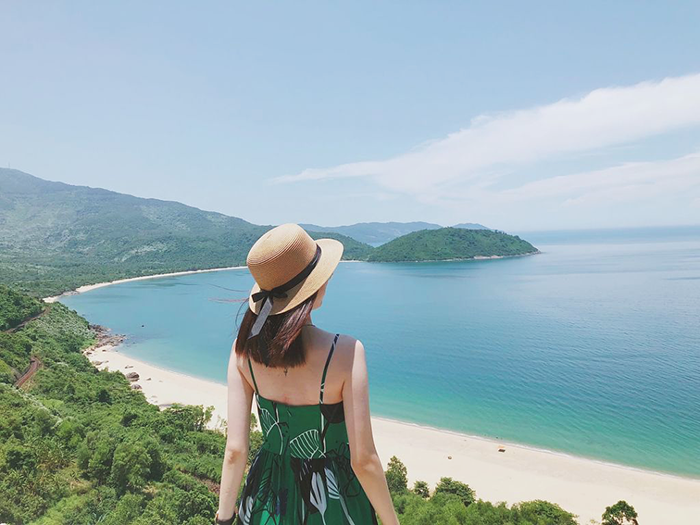
Beyond being a beach destination, Lang Co integrates long-term development plans with a deep-water port, commercial areas, and internationally-sized industrial zones. The beach aims to serve as a resort, providing relaxation and a splash of blue for the bustling urban area. On June 6, 2009, Thua Thien Hue officially received the title of Lang Co Bay as one of the world’s beautiful bays, as voted by Worldbays.
Hai Duong Beach
Hai Duong Beach in Hue possesses a serene and untouched charm, as tourism development in this area is still relatively low. What makes this beach distinctive are two incredibly unique check-in spots created by locals to break the waves, aptly named the “low beach” and the “high beach.”
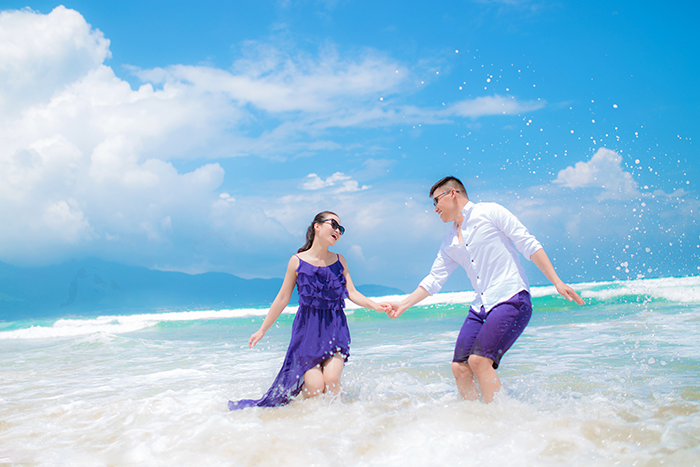
The “low beach” features sturdy, moss-covered, screw-shaped concrete wave barriers. On the other hand, the “high beach” consists of randomly stacked, gigantic three-legged stone slabs. This promises to be an exceptionally cool check-in location that you definitely shouldn’t miss!
Thuan An Beach
- Address: Thuan An Town, Phu Vang District, Thua Thien Hue Province
When thinking of the most picturesque beaches in Hue, one cannot overlook the name Thuan An, a familiar tourist destination for many. Located 15km east of the city center, it is a praised and bustling spot for visitors.
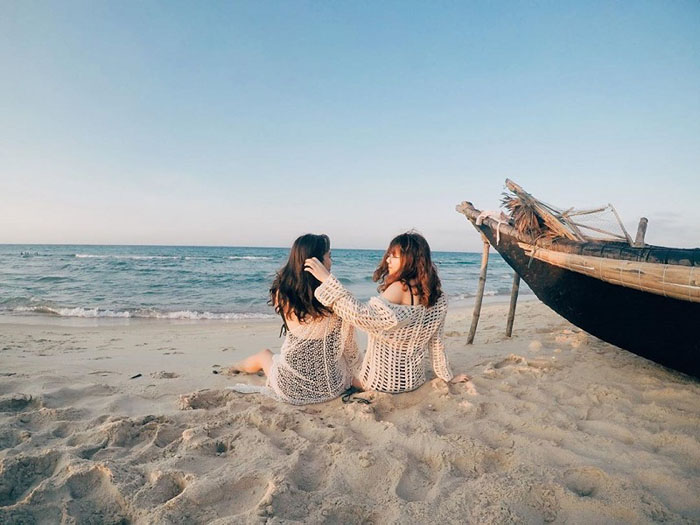
Thuan An Beach is right next to the estuary of the same name, where the Perfume River flows toward Tam Giang Lagoon before pouring into the sea. In the hot summer or sweltering weather, this area becomes the busiest.
Canh Duong Beach
- Address: Canh Duong Hamlet, Loc Vinh Commune, Phu Loc District, Thua Thien Hue Province
If you want to set aside all the worries of life, Canh Duong Beach is the place to help you do just that. The enchanting beauty of the sea in this legendary land is only 60km from the city center, with a length of 8km, a width of 200km, and a crescent shape. The gentle slope, along with the smooth white sand and relatively sheltered location, is what Canh Duong Beach possesses.
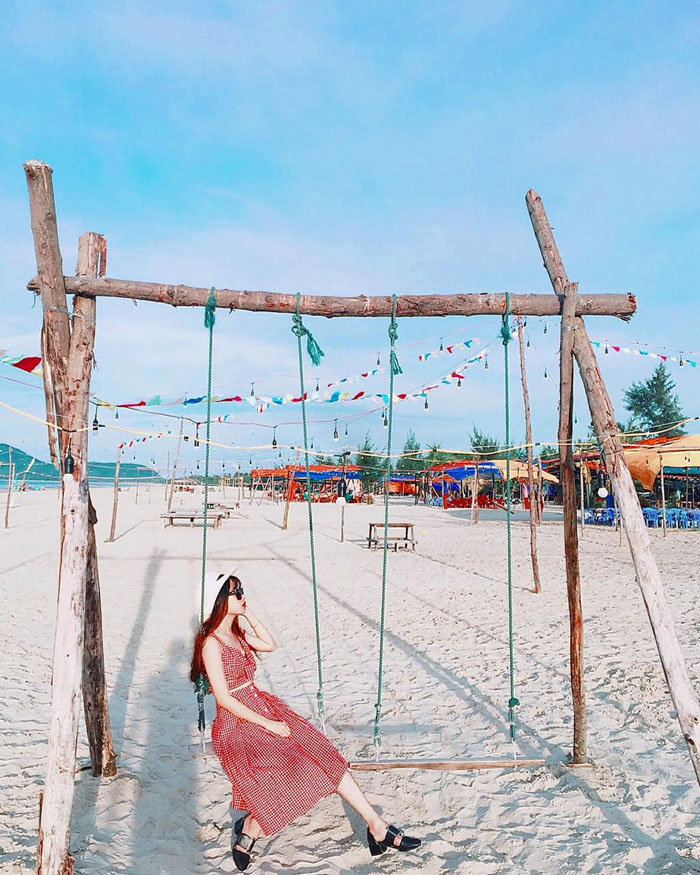
Visiting this tourist destination in Hue, you not only enjoy the scenery but also indulge in famous local seafood such as steamed clams, grilled squid, shrimp, salt-roasted crab, and more. Just hearing the names is enough to make one crave.
Vinh Thanh Beach
Located just about a 30-minute drive from the center of Hue, Vinh Thanh is renowned for being one of the cleanest and most seafood-abundant beaches with exceptionally fresh air in the imperial land. Here, you will experience an immensely vast seascape, with a clear blue sky, harmonious sunshine, and gentle breezes. The most fascinating aspect of visiting this Huế beach is the opportunity to engage with and experience the livelihoods of the sincere, amiable, and hospitable local fishermen in Vinh Thanh village.
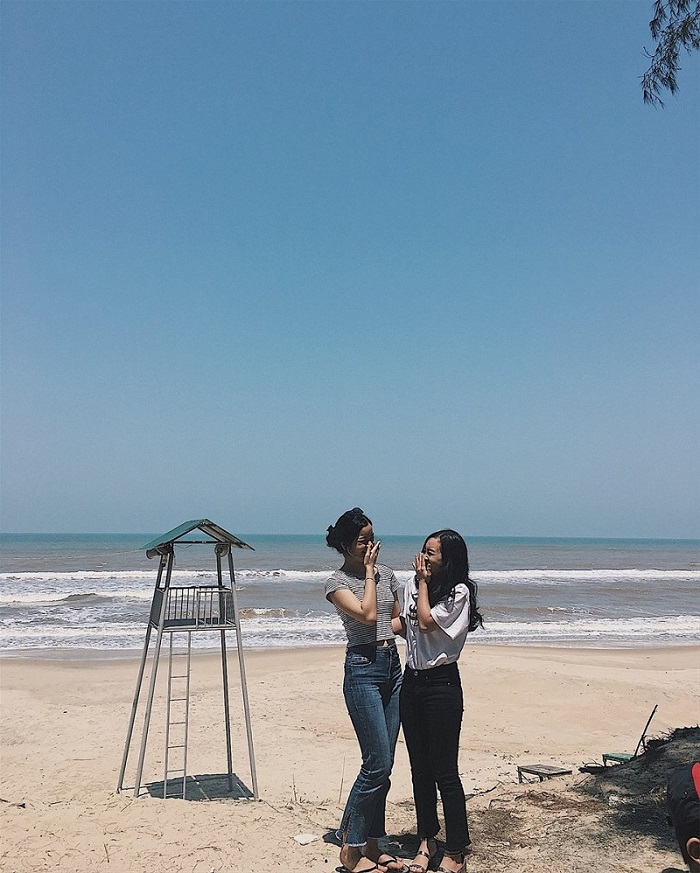
Different Scenic Spots in Hue
Thuy Tien Lake Water Park
Despite being abandoned for a long time, strangely, Thuy Tien Lake Water Park is a destination that attracts attention from foreign tourists and receives international acclaim.
No park in Vietnam, regardless of its type or operational status, has garnered as much foreign media attention as the abandoned Thuy Tien Lake Water Park. The park was featured in well-known publications such as the U.S.-based Huffington Post in 2016 and 2019, which suggested that the place is not for the faint-hearted. The CNN news channel included the lake in its list of the world’s 10 mesmerizingly beautiful abandoned amusement parks, but one that has been “closed indefinitely.” The Washington Post ranked Thuy Tien Lake among the 11 captivating yet eerie abandoned parks. Thuy Tien Lake has also appeared in international music videos.
Bach Ma Mountain
After the resistance against the French ended in 1945, Bach Ma Mountain was nearly forgotten. The picturesque landscapes in this area remained untapped until 1960 when the government started developing and planning to preserve the beauty. The Bach Ma National Park was established, and the Bach Ma Area was used as a base for subsequent battles with the United States.
After 1975, with the return of peace, the state began to focus more on this scenic area, cultivating it to enhance its greenery and officially welcoming visitors. Bach Ma Mountain, with an elevation of 1444m, features waterfalls, streams, forests, creating the most exhilarating natural scenery. It is also a home to many rare species of tropical animals and plants.
Ngu Binh Mountain
- Address: Ngu Binh Mountain, An Cuu, Hue City, Thua Thien Hue
Many poems and songs have described Ngu Binh Mountain to capture its poetic beauty. Unlike other mountains with sharp triangular peaks, Ngu Binh has a unique trapezoidal shape, making it distinct. Adjacent to Ngu Binh are two “siblings” named Ta Bat Son and Huu Bat Son.
Historical records mention that during the reign of King Gia Long, all officials in the court had to plant a pine tree on Ngu Binh Mountain. Throughout the king’s life, the pine forest on Ngu Binh was always lush and vibrant. Harmonizing with the gentle beauty of the Perfume River, Ngu Binh Mountain has become a preferred tourist destination in Hue.
Instead of simply calling it Hue, many tourists prefer to refer to the land as the “Perfume River – Ngu Binh Mountain” region, emphasizing the long-standing connection between this scenery and the legendary land.
Perfume River
The Perfume River flows through various places such as Huong Tra, Huong Thuy, Phu Vang, in Thua Thien – Hue province, making it a romantic highlight of the ancient capital from ancient times to the present.
Anyone who admires the Perfume River praises its beauty, which goes beyond the aesthetics of a flowing river. This beauty reflects the musical and poetic qualities of the legendary land. In Hue, everything is beautiful and peaceful, but to associate them with elegance, the Perfume River is the only one.
According to ancient books, the Perfume River had various names such as Linh River, Kim Tra River, Huong Tra River, Lo Dung River, Dinh River, Yen Luc River…
Tinh Tam Lake
This lake was originally a section of the Kim Long River. The lake has a circumference of about 1500m, with a surrounding brick wall and three islands outside named Bong Lai, Phuong Truong, and Doanh Chau. Harmony with nature and beautiful architecture highlights the romantic beauty of this place.
This place is one of the tourist spots in Hue, inspiring many works of poetry and literature. Part of the poem “Landscape of Tinh Tam Lake” by King Trieu Tri drew inspiration from this location.
Truoi Lake
- Address: Truc Lam Bach Ma Monastery
About 30km south of Hue city is Truc Lam Bach Ma Monastery. Throughout the year, this place is covered in white clouds, resembling the mystical realm of Bong Lai. The surrounding area is Truoi Lake, clear and calm water throughout the four seasons.
The lake is known to be the largest hydraulic project in Thua Thien – Hue province, and it is a popular tourist destination in Hue, especially attracting many visitors during hot summer days. Many groups of people come to the ferry landing to explore and enjoy the fresh air.
Boat rides for sightseeing around the lake have become popular, and this activity has started to flourish. Each boat can carry an average of 15-20 passengers, and the fare per trip is around 200k – 250k.
Thanh Toan Tile Bridge
- Address: Thanh Thuy Chanh Village, Phu Vang, Thua Thien–Hue
This destination is the tile-roofed bridge over the canal in Thanh Thuy Chanh Village. The bridge has an arched roof made of tiles. The bridge was first built more than two centuries ago. After many wars and damages, Thanh Toan has been renovated and repaired several times. Renovation occurred in 1847, 1906, 1956, and 1971.
Although the length is only 16.85m, this place is still one of the tourist spots in Hue that many people visit every year.
Truong Tien Bridge
Truong Tien Bridge, also known as Trang Tien Bridge, is a bridge with a length of 402.6m, including 6 arch spans. In literature and art, the bridge has often appeared with a poetic and culturally significant beauty.
During the Tet Mau Than event, Truong Tien was a “victim” with pillars and span 4 being destroyed. To connect the two banks temporarily, the revolutionary army used a pontoon bridge. Only later was the bridge rebuilt. In 2002, for the Hue Festival, Trang Tien was decorated with a modern lighting system.
In 2004, the bridge officially changed its name to Truong Tien in a unified and legal manner. However, due to the habits of the local people, the confusion between the two names still frequently occurs in daily conversations.
Vong Canh Hill
- Address: Huyen Tran Cong Chua, Thuy Bieu, Hue City, Thua Thien Hue
If you want to admire the dreamy land of Hue, you should visit Vong Canh Hill, where the peaceful atmosphere blends with the natural beauty of the river. This tourist destination in Hue has enchanted many travelers due to the surrounding scenery and the impressive road leading to it.
Vong Canh has a height of 43m. On one side, you can see the Perfume River, and on the other side, you can see the entire lush green pine forest covering the city. Especially if you pay attention, you can even see the Huyen Chau Temple and the Vannien Water Plant not far away.
Moreover, there is a very attractive winding slope on the hill. Experiencing the view from above the city in the pleasant, comfortable air and the peaceful breeze will create unforgettable memories.
Phan Boi Chau Monument
- Address: 53 Le Loi, Ward 11, Phu Hoi, Hue City, Thua Thien Hue
Tourist destinations in Hue are not just for sightseeing but also for exploring the cultural and traditional values of the nation. Here, there is a sculpture of a famous historical figure that everyone knows, Phan Boi Chau.
The statue is named “Old Man of Ben Nghe,” sculpted by the renowned artist Le Thanh Nhon with the assistance of more than 20 student sculptors. The statue is considered a cultural heritage protected by UNESCO, and in terms of size, it is one of the largest statues in Hue. Originally, the statue was supposed to be placed by the romantic Perfume River, but until now, it has only found its place on Le Loi Street.
Temple of Literature
- Address: 23 August Street, Phu Hau, Hue City, Thua Thien Hue
The Temple of Literature is now the Museum of History and Revolution of Thua Thien Hue Province. Previously, this tourist destination in Hue was the only university during the feudal period. Although it has now ceased its role, what the school contributed to the country is a series of talents and over 500 doctors under the Nguyen dynasty.
Currently, this structure is quite intact, which is fortunate compared to other works in Hue. Since the Temple of Literature was established, the education system in Hue has undergone more than two centuries. Since the relocation of the Temple of Literature to Phu Xuan, it also meant the end of the Hoi – Dinh examination.
Bach Ma National Park
Address: Phu Loc, Thua Thien Hue
Bach Ma National Park is an area with a very high biological diversity, containing many rare plant species, including over 2147 species. Among them are many rare and highly valuable species listed in the Red Book for conservation.
In terms of animals, this tourist destination in Hue has over 1493 species of wild animals, some rare species recently discovered, such as the Saola. There are over 894 species of insects here, with the largest number belonging to the scale-winged order with 310 species, and the smallest number belonging to the membrane-winged order with 3 species, 3 genera, and 3 families.
Lap An Lagoon
- Address: Phu Loc District, Hue
Lap An Lagoon, also known as Vung An Cu, is one of the brackish water lagoons in Hue. Located near the picturesque Gia Phu Pass, this area covers an area of over 800 hectares, surrounded by the towering Bach Ma Mountains. Lap An Lagoon is among the popular tourist destinations in Hue, especially known for its peaceful and tranquil ambiance.
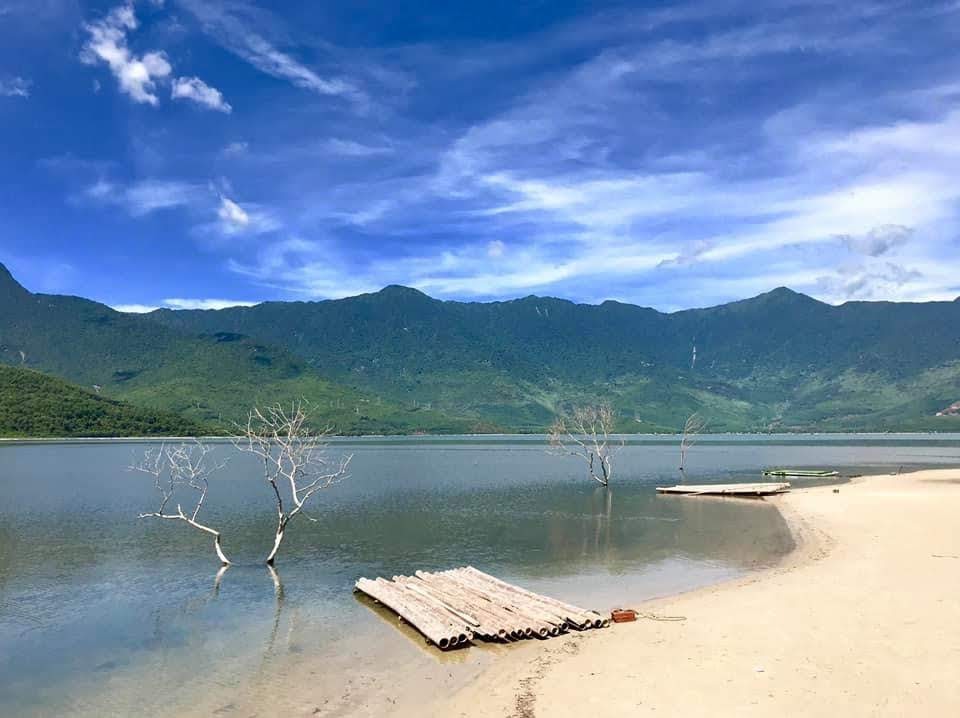
The lagoon resembles a natural painting with its picturesque landscapes, a perfect blend of land and water gifted by Mother Nature. The enchanting beauty of this place can be mesmerizing, especially during sunrise or sunset. In reality, this seems like a “heavenly realm” for travelers.
Lau Tu Phuong Vo Su (Tu Phuong Pavilion)
- Address: Dang Thai Than, Phu Hau, Hue City, Thua Thien Hue
Tu Phuong Pavilion is a two-story architectural structure inaugurated in 1923. In the past, the pavilion served as a resting and cooling place for the kings. Every day, princesses often came here to study and enrich their knowledge.
It is also considered a typical construction during the French colonial period. Under the impact of war, the pavilion suffered many serious “wounds.” In 2008, the renovation project for this area began, with a total cost of 9.3 billion VND.
Not only a tourist destination in Hue, but Tu Phuong Pavilion also holds cultural, artistic, and historical values. Visiting this place, tourists will not only expand their knowledge but also experience the relaxing moments of the ancient kings.
Ru Cha Mangrove Forest
- Address: Huong Phong Commune, Huong Tra Town, Hue
If tourists want to enjoy a green and vast space, the Ru Cha mangrove forest is an unmissable destination among the tourist spots in Hue. To reach here, starting from Thuận An port, visitors can explore this area by boat or the fishing boats.
The pristine nature of this place is a highlight that contributes to its fame. Instead of being polished by the human hand with thick layers of concrete, the Ru Cha mangrove forest remains a completely natural destination.
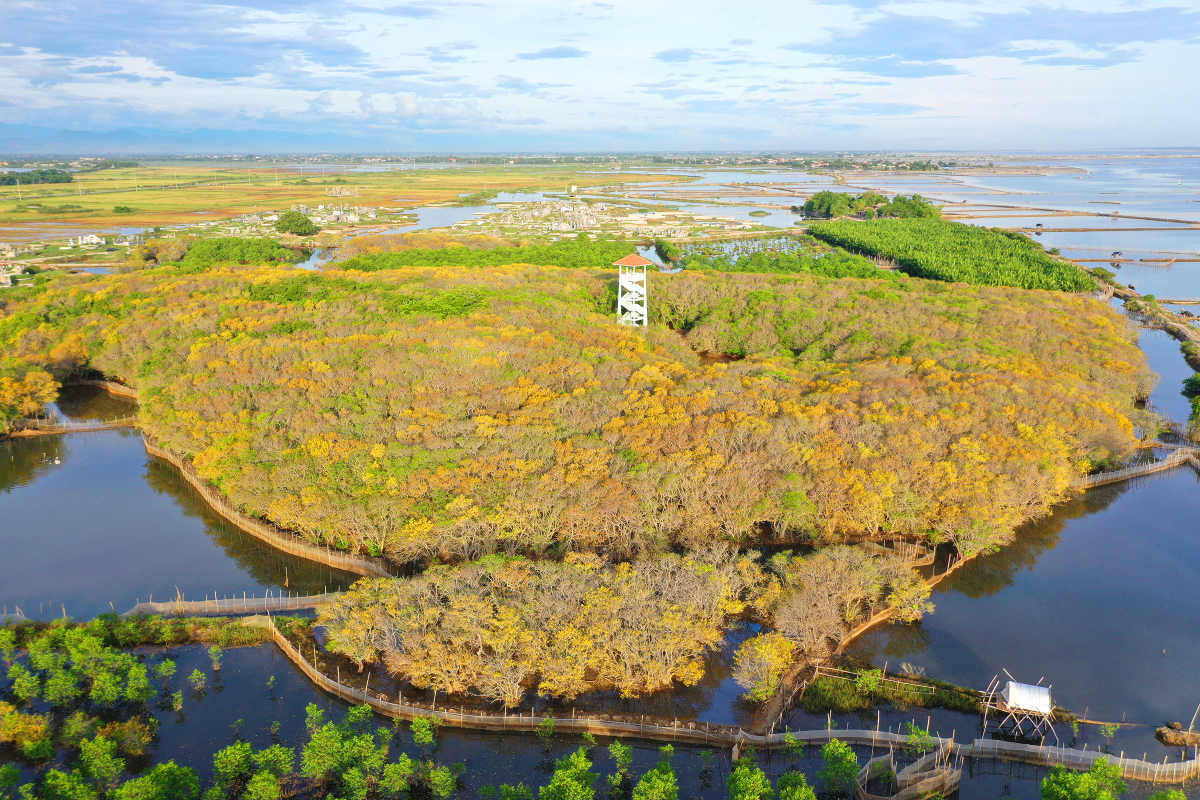
As the only remaining pristine forest in Tam Giang, following the trails, travelers will discover many interesting things. Only one concrete boat was found on the island, but, in reality, it is a temple dedicated to the sea god, symbolizing prayers for safety each time the locals go fishing.
Thuy Xuan Incense Village
Thuy Xuan Incense Village is renowned for its longstanding traditional incense-making craft in Hue. The village also captivates those who enjoy photography with its vibrant scenery of colorful bundles of incense in green, red, purple, and yellow hues.
During your trip to Hue, in addition to visiting cultural and historical heritage sites, take some time to explore Thuy Xuan Incense Village. This is where you can learn about the incense-making process, experience various stages, and capture moments in a beautifully diverse and colorful environment
Phu Cam Conical Hat Village
- Address: Phuoc Vinh Ward, Hue City Center
For a long time, we have often heard about the “poem hat” as a characteristic of Hue, so although there are many tourist destinations in Hue, you definitely cannot miss Phu Cam Conical Hat Village.
The image of a Hue girl wearing a purple ao dai and a conical leaf hat is not only a symbolic image but also a cultural representation, representing the gentle, ancient, and traditional features of the entire city.
When visiting Phu Cam Conical Hat Village, tourists will witness the skillful hands weaving various conical hats right on the spot, carrying the true essence of Hue. Although it is somewhat “overshadowed” compared to the famous landmarks in the region, if you have time, you should visit this place and explore it.
Pe Ker Pass
Hue not only has Hai Van Pass, but it also has Pe Ker Pass, which many people often overlook. For those who like to explore Hue from above but fear the twists and turns of Hai Van, Pe Ker is the place to go.
From A Nor waterfall, visitors only need to go straight north about 10 km to reach the destination and admire the most poetic natural scenery in Hue.
Coming here, to some extent, you will experience strong feelings. These become even more appealing to those who love the strong sense of adventure, exploration, and thrill.
Dong Ba Market
- Address: 2 Tran Hung Dao, Phu Hoa, Hue City, Thua Thien Hue
If Saigon has Ben Thanh Market as its representative image, in contrast, with Hue, Dong Ba Market is the most sophisticated market. Regarded as an icon of this place, no matter how many tourist destinations in Hue you visit, you should not miss Dong Ba Market.
Since the reign of King Gia Long, this market has been present, playing a significant role, bringing the specialties and typical products of Hue to the hands of many visitors. It is known that King Dong Khanh is the one who named Dong Ba for this market.
Hue Archdiocese Cathedral – Phu Cam Church
Unlike the tombs, citadels, or ancient religious structures in Hue, Phu Cam Church features a modern and impressive architectural style.
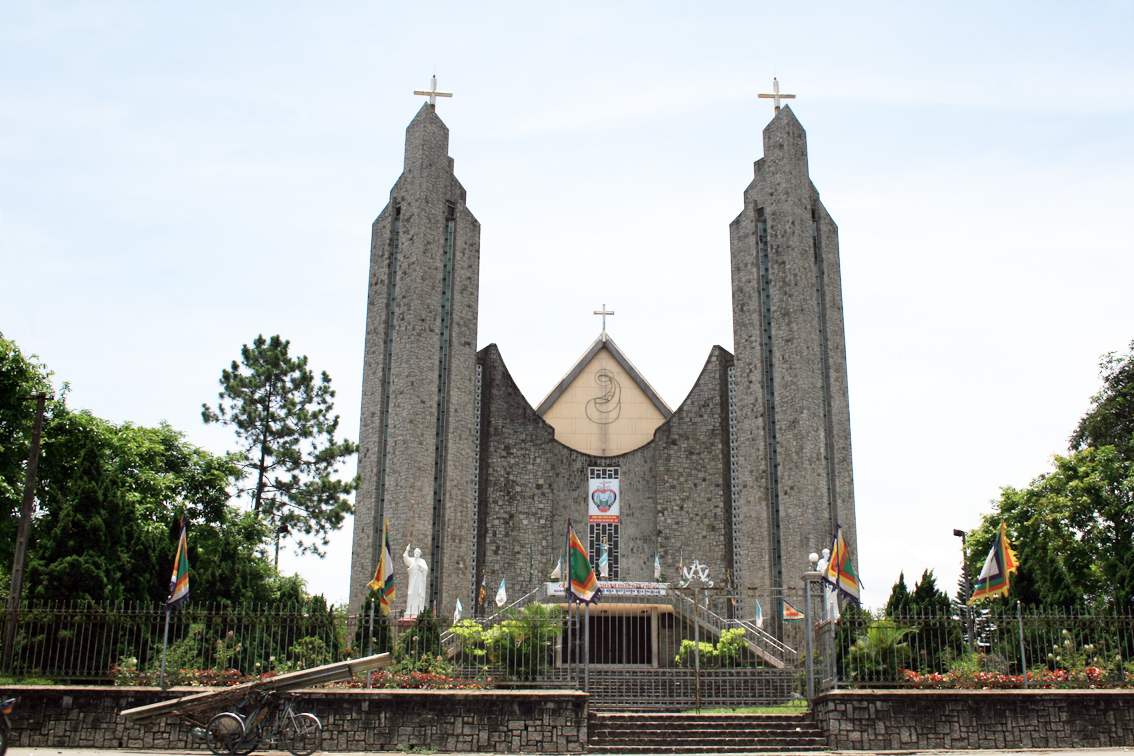
Phu Cam Church is a work of high historical and architectural value, representing a significant and precious creation by the architect Ngo Viet Thu for the city of Hue. Alongside other structures like Hue University, Hue Pedagogical University, Huong Giang Hotel, and Century Hotel, this building stands as a distinctive mark of modern architecture and deserves to be considered a new-age heritage of Hue.
Above are the top 50+ tourist attractions in Hue that attract a large number of visitors. VnCarRentals.com hopes that this article will become a useful travel guide for your upcoming trips. Wishing our readers a safe and enjoyable journey!


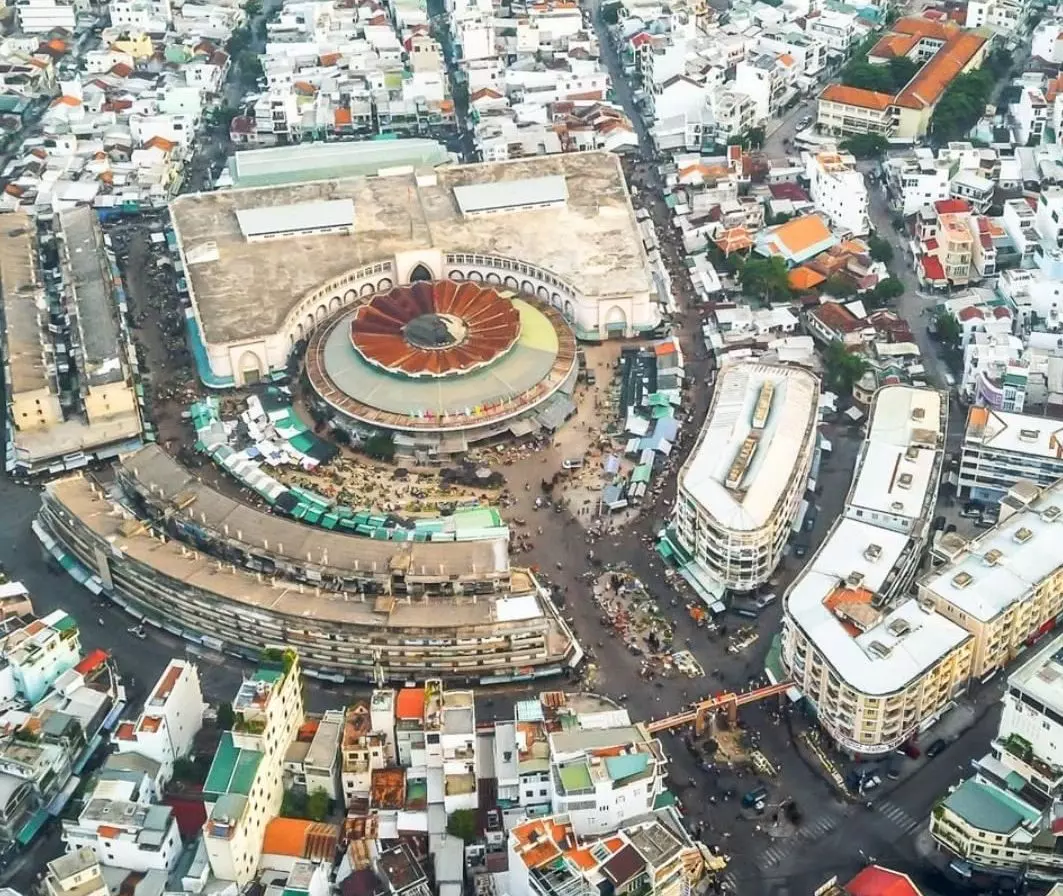
[…] Mang Tomb in Hue is one of the significant tourist attractions in Hue, a must-visit destination for travelers exploring the city. When you come here, you will have the […]
[…] you are planning a trip to the Central region, you should visit this tourist attractions in Hue. Below, VnCarRentals.com’s will share some experiences for exploring this over 300-year-old […]
[…] Hieu Pagoda is a well-known spiritual and ancient tourist attractions in the ancient capital of Hue. Every day, a large number of people visit this place for sightseeing and worship. If you have the […]
[…] of the must-visit tourist attractions in Hue is undoubtedly the Tomb of Tu Duc. This is the tranquil resting place of King Tu Duc, a monarch of […]